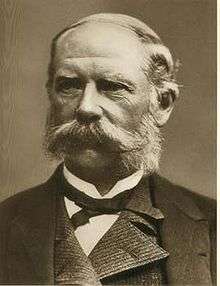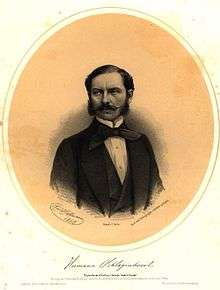Hermann Schlagintweit


Hermann Schlagintweit, Sakünlünski (13 May 1826 – 19 January 1882), also known as Hermann Rudolph Alfred von Schlagintweit-Sakünlünski, was a German explorer of Central Asia.
Life
The eldest of the five Schlagintweit brothers of Munich, along with his brother Adolph, he published a scientific study of the Alps in 1846–1848. They established their reputation with the Untersuchungen über die physikalische Geographie der Alpen (1850), and were afterwards joined by brother Robert, and jointly published Neue Untersuchungen über die physikalische Geographie und Geologie der Alpen in 1854.[1]
In 1854, acting on the recommendation of Alexander von Humboldt, the East India Company commissioned Hermann, Adolf, and Robert to make scientific investigations in their territory, and particularly to study the Earth's magnetic field. For the next three years, they travelled through the Deccan, then up into the Himalayas, Karakoram, and Kunlun mountains. Hermann and Robert were the first Europeans to cross the Kunlun, for which achievement Hermann received the title "Sakünlünski".[1]
Hermann visited Nepal, then returned to Europe, where with Robert he published Results of a Scientific Mission to India and High Asia (four vols., 1860–1866). He spent the remainder of his life in literary and scientific work, both at Munich and at the Schloß Jägersburg castle near Forchheim.[1]
Selected works

- Untersuchungen über die physikalische Geographie der Alpen, 1850.
- Neue Untersuchungen über die physikalische Geographie und Geologie der Alpen, 1854.
- Results of a scientific mission to India and high Asia: undertaken between the years MDCCCLIV. and MDCCCLVIII., by order of the court of directors of the Honorable East India Company / by Hermann, Adolphe, and Robert de Schlagintweit : with an atlas of panoramas, views and maps, Leipzig : F.A. Brockhaus ; London : Trübner & Co., 1861-66.
- Neue daten über den todestag von Adolph v. Schlagintweit, nebst bemerkungen über mussălmán’sche zeitrechnung, München, Akademische buchdr. von F. Straub, 1869.
- Reisen in Indien und Hochasien. Eine darstellung der landschaft, der cultur und sitten der bewohner, in verbindung mit klimatischen und geologischen verhältnissen. Basirt auf die resultate der wissenschaftlichen mission von Hermann, Adolph und Robert von Schlagintweit, ausgeführt in den jahren 1854-1858, Jena, H. Costenoble, 1869-80.
- Bericht über die ethnographischen gegenstände unserer sammlungen und über die raumanweisung in der K. Burg zu Nürnberg ..., München, Buchdruckerei von F. Straub, 1878.
References
- 1 2 3 Chisholm 1911.
- Attribution
![]() This article incorporates text from a publication now in the public domain: Chisholm, Hugh, ed. (1911). "Schlagintweit". Encyclopædia Britannica (11th ed.). Cambridge University Press.
This article incorporates text from a publication now in the public domain: Chisholm, Hugh, ed. (1911). "Schlagintweit". Encyclopædia Britannica (11th ed.). Cambridge University Press.
External links
- Die Geschichte der Brüder Schlagintweit A detailed story of the adventures of the three brothers Hermann, Adolf and Robert in India and the Himalayas. (German)
ter